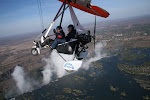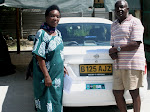



Xugana Island Lodge
Okavango Delta
October 6, 2008
My road trip to the Tsodilo Hills and Etsha 6 last week had been a goal of mine for months. I must thank Kitso, a former Xugana guide, for helping make the trip happen. When I was volunteering at Xugana Island Lodge in June, I heard that his sister in Etsha 6 made beautiful baskets. I promptly began peppering Kitso with questions about his village’s reputation as a basket-making center, acclaimed as the best in Botswana. I made a pushy and no doubt culturally impolite request that he introduce me to his sister someday; I wanted to see her at work and talk with her. He graciously agreed, and so last week we went to Etsha 6 for Kitso to begin his 11-day time-off from Camp Moremi and for me to meet his sister.
You’ll see in my photos Ipolokeng Montsheki, whose first name means “beauty.” I was told I was welcome to call her that. I visited her first at Kitso’s house, where she was sitting under a big shade tree that sheltered the laundry buckets used for all the compound’s washing. It was clear that Kitso would have to translate any conversation I had with Ipolokeng. Not many white people stay overnight in Etsha 6, and, throughout the village, an American accent throws Setswana-speaking people into confusion easily. Beauty and I quietly sat next to each other for a while. I wanted to keep my interruption of laundry time to a minimum.
I went to visit Ipolokeng again at the Rush Inn, a butchery stacked with dripping chunks of red meat. That’s where she works. Between serving customers she sits outside to make baskets.
Through Kitso’s translation Ipolokeng told me it’s not easy to find the fan palms she uses for the fiber for basket making. She has to walk far to find them. Kitso said about 60 percent of the women do basketry in Etsha 6 to earn money for their households; everyone is looking for the same plants. After collecting the leaves Ipolokeng boils them in water, then dips them in cold water. This process renders a natural color for the baskets. If she wants dark colors for her original patterns and designs, she relies on different kinds of tree bark to achieve the colors she wants. She pounds the tree bark into powder to put into the water. Bird plum and magic guarri (Kitso wasn’t sure of the spelling) are two types of trees whose bark comes in handy for color variation.
Ipolokeng’s mother taught her the art of basketry. The tools are simple: an awl and a bowl of water for dipping the leaves and one’s fingers to ensure pliability of the fibers. The process, however, is anything but easy. The coiled baskets take a long time – up to two weeks for a small platter, up to two months for a basket Ipolokeng made that was half a meter high. A fine basket has a tight center, a weave that is not rough and no strings askew in the pattern, she said.
I loved her baskets. She had only a few, all of which were promised to someone who had made a special order. I didn’t want to give up and leave famed Etsha 6 without a basket. Anyone who knows me knows that I am an art lover. How could I leave Botswana without taking home a treasure by one of the artists with whom I was now acquainted? I tried my luck. Would Ipolokeng consider selling me the covered basket at a premium and then make another one for the client? I am most grateful that she agreed. You’ll see a photo of her holding my basket in her lap.
Despite my unfortunate encounter with bedbugs at the Etsha 6 accommodation, I remain glad that I made the trek to the village on the western side of the Okavango Delta to learn about basketry and to meet one of Botswana’s artists. In a world I inhabit that is too often filled with artifice, I found in Etsha 6 something different: authenticity -- Beauty, form and function -- a worthwhile road trip indeed.
P.S. Below are book excerpts that describe the area and its artistry.
From “African Basketry: Grassroots Art From Southern Africa” by Anthony B. Cummings and M. Elizabeth Terry:
“In many parts of the world, indigenous and minority peoples occupy remote areas. This remoteness has been a major factor in maintaining habitats and societies intact. It has also been a factor in the retention of basketry skills. It is no coincidence that the most beautiful baskets are products of dusty, dry, drought-prone landscapes. Basket-making is hard work and the finest basket-making skills often belong to the poorest households….
In the early 1960s Etsha teemed with wildlife. By the early 1980s, there were millet fields devoid of trees, yet getting there from the district centre of Maun still took eight hours of grinding along in four-wheel drive. There was no electricity or telephones, and the best way to get a ‘quick’ message was by telegram sent by hand from Maun. The past 20 years brought remarkable change. In 1986, the first computer run by a generator appeared in the nearby village of Gomare. By 1992, a tar road linked Etsha to Maun, reducing the trip to a comfortable three hours. Five years later, Etsha had a microwave tower for communication by cell phone and computers linked to the Internet, where Etsha schoolchildren could view international websites selling baskets from their village, complete with photographs of basket makers they knew.
Despite these dramatic changes, there is still continuity with the past in Etsha and many villages across southern Africa. The sound of women pounding millet in mortars with pestles still resounds past thatched homes and across open fields. Women still walk home barefoot in the setting sun with baskets on their heads full of household possessions.
“Many people have the idea that a basket is something that can be made in just a few hours and requires little skill. In fact, basket making is a difficult and time-consuming business. When one considers the actual weaving time, let alone the time needed to collect and prepare the raw materials, the number of hours is staggering.
Weaving time varies according to the type of weave and, in the case of coil-built baskets, the size of the coils, the size and spacing of each stitch, and the type of material used for wrapping. For example, an average (30 centimeters diameter by 7 centimetres high) coiled bowl-shaped basket made from palm fibre with medium-size coils and close stitches will take, on average, 25 hours to complete. For some basket makers, however, as may as 40 and even up to 80 hours may be needed. A further 16 hours must be added to include the time taken to collect the palm fibre and dye materials; to collect the water and firewood needed to prepare the palm; to sort, process and dye the palm or roots; and to travel to the nearest craft buying centre to sell the basket….
Even those weavers who weave quite steadily cannot do so for much longer than five to six hours every day. This is due to the sore neck, eye-straining and backbreaking nature of basket making, apart from other commitments around the household such as carrying water, gathering firewood, food preparation and childcare. This means that an average sized, bowl-shaped, coiled basket can take from two weeks to one month to produce.”















































